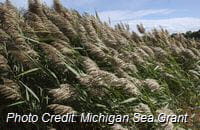 |
| Brian Sullivan - Cornell |
In recent years, increasing numbers of pelicans have been sighted in southeast Michigan at the edge of Lake Erie. Initially they were thought to be migrating to and from summer breeding grounds far to the west. Lately, however, as many as 60 of the birds have been seen throughout the summer at Michigan’s Pointe Mouillee State Game Area.
The American White Pelican is a large bird with a nine foot wingspan. In recent decades, their population has been increasing. They feed by simultaneously swimming and skimming the water with their large lower beak pouches, often in coordination with one another, to catch fish.
Most of these pelicans winter along the U.S and Mexican Gulf coast or on the southern California coast and along the Baja Peninsula. In the spring, most migrate to nesting areas near or on Canadian inland waters in the provinces of Alberta and Saskatchewan, some in the Dakotas in the U.S.
Pointe Mouillee State Game Area is just south of the convergence of the Detroit River and Huron River at the western end of Lake Erie

